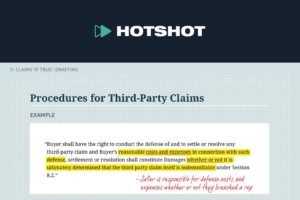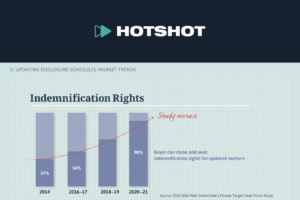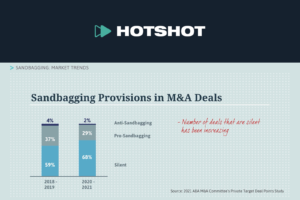This is a summary of the Hotshot course “Materiality Scrapes: Buyer and Seller Perspectives,” a discussion of the perspectives and negotiating positions of buyers and sellers regarding materiality scrapes in acquisition agreements. View the course here.
Buyer and Seller Perspectives
- Buyers and sellers have different perspectives on materiality scrapes.
- Buyers like them because they reduce the buyer’s financial risk for smaller, or immaterial, matters.
- Sellers typically dislike them (especially breach scrapes) because they:
- Create potential liability for immaterial matters; and
- Increase the amount of information sellers need to include in the disclosure schedules.
- When the buyer gets a rep & warranty insurance policy, the debate over materiality scrapes becomes much less important.
- The parties often agree to include scrapes with little or no negotiation.
Damages Scrapes
- Damages scrapes usually aren’t heavily negotiated.
- Buyers often want to include them and sellers are usually comfortable with that.
- Most sellers don’t think the provision increases their liability since a damages scrape doesn’t affect what constitutes a breach.
- There’s also the issue of “double materiality”, which in this context means the buyer:
- First must prove that the damages are material to show a breach of the rep.
- Then must prove that damages caused by the breach exceed the basket or deductible. The basket or deductible acts as a second materiality standard on the size of damages that applies to the seller’s reps.
- Sellers often choose not to fight to retain the double materiality protection
provided by a damages scrape.
Breach Scrapes
- Breach scrapes are usually heavily negotiated and much more consequential than a damages scrape.
- They’re what buyers and sellers care most about in the context of materiality scrape negotiations.
- Sellers’ perspective:
- The concern for the seller with a breach scrape provision is that even though the reps in an acquisition agreement were negotiated to include materiality qualifiers or similar concepts, these materiality qualifiers are essentially removed from the reps in the acquisition agreement as a whole for indemnification purposes.
- This means that the seller can be responsible for indemnifying the buyer for a greater amount of losses with a breach scrape than without one.
- In addition, when an agreement has a breach scrape, the seller’s lawyers tell the seller to include all exceptions to the reps in the disclosure schedules (however immaterial) to avoid indemnification claims.
- The concern for the seller with a breach scrape provision is that even though the reps in an acquisition agreement were negotiated to include materiality qualifiers or similar concepts, these materiality qualifiers are essentially removed from the reps in the acquisition agreement as a whole for indemnification purposes.
- Buyers’ perspective:
- Buyers like breach scrapes for the reasons sellers oppose them.
- Buyers want to be able to be made whole as a result of any breach of a rep without having to worry if the breach is material.
- They’d also like to receive disclosure schedules that are as complete as possible.
- In other words, they like the liability and disclosure implications of breach scrapes.
- Buyers like breach scrapes for the reasons sellers oppose them.
Rep and Warranty Insurance
- When the buyer purchases rep & warranty insurance, the debate over materiality scrapes is much less important.
- This is because a rep and warranty insurance policy will generally include a scrape for both breaches and damages as long as the purchase agreement also contains a double materiality scrape.
- The insurance would then typically cover the liability for breach claims.
- The seller therefore generally has very little at stake and will usually agree to a double materiality scrape.
- However, the parties don’t always know from the start if the deal will have rep and warranty insurance.
- Therefore, they often have to negotiate on the assumption that there won’t be.
- Also, for very large deals, insurance may not be cost effective because:
- The retention amount could be too high; and
- The cost of purchasing insurance could be very expensive.
The rest of the video includes interviews with ABA M&A Committee members Rita-Anne O’Neill from Sullivan & Cromwell LLP and Craig Menden from Willkie Farr & Gallagher LLP.

















